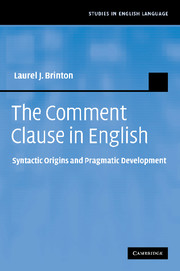Book contents
- Frontmatter
- Contents
- List of figures
- List of tables
- Acknowledgments
- List of abbreviations
- 1 Introduction: comment clauses, parentheticals, and pragmatic markers
- 2 Semantic and syntactic development of pragmatic markers
- 3 Processes of change
- 4 Comment clauses with say
- 5 I mean
- 6 Comment clauses with see
- 7 If you will and as it were
- 8 Comment clauses with look
- 9 What's more and what else
- 10 Epistemic/evidential parentheticals – I gather and I find
- 11 Concluding remarks
- References
- Author index
- Subject index
2 - Semantic and syntactic development of pragmatic markers
Published online by Cambridge University Press: 12 July 2009
- Frontmatter
- Contents
- List of figures
- List of tables
- Acknowledgments
- List of abbreviations
- 1 Introduction: comment clauses, parentheticals, and pragmatic markers
- 2 Semantic and syntactic development of pragmatic markers
- 3 Processes of change
- 4 Comment clauses with say
- 5 I mean
- 6 Comment clauses with see
- 7 If you will and as it were
- 8 Comment clauses with look
- 9 What's more and what else
- 10 Epistemic/evidential parentheticals – I gather and I find
- 11 Concluding remarks
- References
- Author index
- Subject index
Summary
Introduction
This chapter looks at the semantic development of pragmatic markers (about which there seems to be considerable agreement) and their syntactic development (which has not been fully explored). While it is recognized that pragmatic markers come from a wide variety of sources, ranging from individual lexemes to phrasal collocations and clauses, little attention has been given to the syntactic paths of development. The question explored in this chapter is whether we find syntactic clines in the development of pragmatic makers comparable to the semantic–pragmatic clines that have been postulated. A working hypothesis is that semantic–pragmatic change and syntactic change go hand-in-hand: that is, the shift from content meaning based in the argument structure at the clausal level to pragmatic–procedural meaning at the discourse level will be accompanied by a syntactic shift from an item having scope over phrasal and then clausal elements and, ultimately, to its having scope over more global elements of the discourse.
Semantic Development
As pragmatic markers are typically seen as “empty” markers devoid of lexical content, “bleaching” was the traditional way to account for their development. However, in a groundbreaking study, Traugott (1982) argued that a variety of different forms in language, including pragmatic markers, follow a semantic–pragmatic path in their evolution from propositional meaning to textual meaning to expressive or interpersonal meaning. Traugott adapted these three levels of meaning from Halliday's functional components: the ideational (“language as representation”), the textual (“language as relevance”), and the interpersonal (“language as interaction”) (1979).
Information
- Type
- Chapter
- Information
- The Comment Clause in EnglishSyntactic Origins and Pragmatic Development, pp. 24 - 48Publisher: Cambridge University PressPrint publication year: 2008
